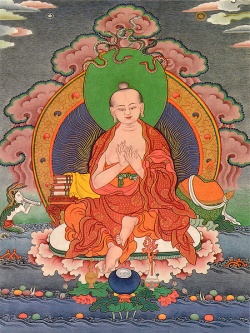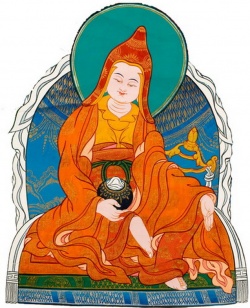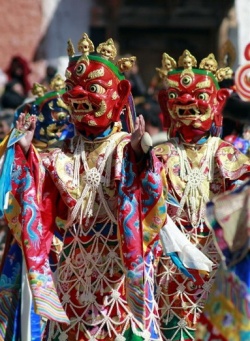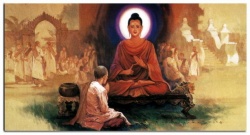The Sūrya-siddhānta on Yugas, Manvantaras, and Kalpas
- The Sūrya-siddhānta on Yugas, Manvantaras, and Kalpas
By David Reigle on August 4, 2012 at 3:04 am
As can easily be seen from the sources mentioned in the May 15 posting on the Sūrya-siddhānta, the information on yugas, manvantaras, and kalpas in the Sūrya-siddhānta is found in chapter 1, verses 15-24, and 45-47 (or 44-46 in the Sanskrit edition with the commentary by Parameśvara There are adequate English translations, by Rev. Ebenezer Burgess (1860), by Bāpū Deva Śāstrī (1861), and by Bimalā Prasāda Siddhānta Sarasvatī (from Sanskrit to Bengali,1894 or 1896, and from Bengali to English, 2007).
Nonetheless, these verses are here given in Sanskrit and English translation, primarily for convenience of reference. Unless the compiler of the Tiru Ganita Panchanga had access to a more complete manuscript of the Sūrya-siddhānta, this is the data on which the figures for the elapsed years of various epochs given at its beginning would have been based.
The Sanskrit text given here is based primarily on the 1957 edition of the Sūryasiddhānta by Kripa Shankar Shukla with the Sanskrit commentary by Parameśvara (1432 C.E.), in comparison with the 1859 edition by Fitzedward Hall with the Sanskrit commentary by Raṅganātha (1603 C.E.). I have also compared the 1871, 1891, and 1911 editions, and the 1991 edition by Śrīcandra Pāṇḍeya with the Sanskrit commentary by Kamalākara Bhaṭṭa (born 1618 C.E.).
Shukla’s edition gives in footnotes variant readings from the text as found with the Sanskrit commentaries by Mallikārjuna Sūri (1178 C.E.), Yallaya (1472 C.E.), and Rāmakṛṣṇa Ārādhya (1472 C.E.). Shukla also consulted the commentaries by Bhūdhara (1572 C.E.) and Tamma Yajvā (1599 C.E.) for questionable readings.
The fact that all these major commentaries were used by Shukla for his edition does not leave a very high probability that a more complete manuscript, having additional verses here, was available to the compiler of the Tiru Ganita Panchanga.
When putting the Sanskrit into roman script I have divided the words with spaces and hyphens as much as possible.
Also I have made my English translation fairly literal, so that the Sanskrit can more easily be followed. There seems to be no possibility of deriving a figure of eighteen million years for the age of the Vaivasvata manvantara from this data, and this is all that can be found on this topic in the extant Sūrya-siddhānta.
Sūrya-siddhānta, chapter 1
tad-dvādaśa-sahasrāṇi catur-yugam udāhṛtam |
sūryābda-saṅkhyayā dvi-tri-sāgarair ayutāhataiḥ || 15 ||
sandhyā-sandhyāṃśa-sahitaṃ vijñeyaṃ tac catur-yugam |
kṛtādīnāṃ vyavastheyaṃ dharma-pāda-vyavasthayā || 16 ||
15-16. Twelve thousand of those [[[divine]] years, divyaṃ varṣam are called a fourfold yuga (age).
By the count of solar years, that fourfold yuga together with its [opening] sandhi period and [closing] sandhi period is to be understood as four hundred and thirty-two multiplied by ten thousand [i.e., 4,320,000].
This fixed limit of the kṛta and other [[[yugas]]) is by way of the fixed limit of the legs of dharma (righteousness).
Notes: fourfold yuga, consisting of the kṛta, tretā, dvāpara and kali yugas; sandhi or sandhyā = “junction, interval, twilight”; four hundred and thirty-two, dvi-tri-sāgara = “two three ocean,” where ocean is a word-number standing for “four,” and the whole number is to be read backwards.
yugasya daśamo bhāgaś catus-tri-dvy-eka-saṅguṇaḥ |
kramāt kṛta-yugādīnāṃ ṣaṣṭho ’ṃśaḥ sandhyayoḥ svakaḥ || 17 ||
17. The tenth part of a yuga [i.e., 432,000] multiplied by four, three, two, and one in sequence [is the length] of the kṛta and other yugas. Their own sixth part [is the length] of the two sandhi periods [combined].
yugānāṃ saptatiḥ saikā manvantaram ihocyate |
kṛtābda-saṅkhyā tasyānte sandhiḥ prokto jala-plavaḥ || 18 ||
18. Seventy plus one yugas are here called a manvantara. At the end of it is said to be a sandhi period having the number of years of a kṛta [[[yuga]]). It is an inundation by water.
sa-sandhayas te manavaḥ kalpe jñeyāś caturdaśa |
kṛta-pramāṇaḥ kalpādau sandhiḥ pañcadaśaḥ smṛtaḥ || 19 ||
19. Those manus together with the sandhi periods are to be understood to be fourteen in a kalpa (eon). At the beginning of a kalpa is recollected to be a fifteenth sandhi period having the measure of a kṛta yuga.
itthaṃ yuga-sahasreṇa bhūta-saṃhāra-kārakaḥ |
kalpo brāhmam ahaḥ proktaṃ śarvarī tasya tāvatī || 20 ||
20. Thus a kalpa, with a thousand yugas, bringing about the destruction of beings, is said to be a day of Brahmā. His night is of the same extent.
param āyuḥ śataṃ tasya tayāhorātra-saṅkhyayā |
āyuṣo ’rdham itaṃ tasya śeṣāt kalpo ’yam ādimaḥ || 21 ||
21. His complete life is a hundred [[[divine]] years] by this count of days and nights. Half of his life has passed. Of the remainder, this is the first kalpa.
Note: the reading śeṣāt kalpo, found in the edition with the commentary by Parameśvara (and read in the three other commentaries cited in the footnotes), is preferable to the reading śeṣa-kalpo, found in the editions with the commentary by Raṅganātha.
kalpād asmāc ca manavaḥ ṣaḍ vyatītāḥ sa-sandhayaḥ |
vaivasvatasya ca manor yugānāṃ tri-ghano gataḥ || 22 ||
22. Of this kalpa six manus have passed with their sandhi periods. Of the Vaivasvata manu, three cubed [i.e., 27] yugas have passed.
aṣṭāviṃsād yugād asmād yātam etat kṛtaṃ yugam |
ataḥ kālaṃ prasaṅkhyāya saṅkhyām ekatra piṇḍayet || 23 ||
23. Of this twenty-eighth yuga, this kṛta yuga has passed. For calculating time after this, one should combine into one the number.
graha-rkṣa-deva-daityādi sṛjato ’sya carācaram |
kṛtādri-vedā divyābdāḥ śata-ghnā vedhaso gatāḥ || 24 ||
24. Four hundred and seventy-four times one hundred divine years passed of the creator [[[Brahmā]]), he creating the moving and the unmoving, i.e., planets, stars, gods, demons, etc. [at the beginning of the kalpa).
Note: four hundred and seventy-four, kṛta-adri-veda, word-numbers for four (kṛta, the four dots on a winning dice, also the kṛta yuga where dharma stands on all four legs), seven (adri, mountain, the seven mountains), and four (veda, the four vedas). Then the whole number is to be read backwards, although with this particular number it would not matter.
. . . . . . . . . . . . . . . . .
ṣaṇ-manūnāṃ tu sampīḍya kālaṃ tat-sandhibhiḥ saha |
kalpādi-sandhinā sārdhaṃ vaivasvata-manos tathā || 45 ||
yugānāṃ tri-ghanaṃ yātaṃ tathā kṛta-yugaṃ tv idam |
projjhya sṛṣṭes tataḥ kālaṃ pūrvoktaṃ divya-saṅkhyayā || 46 ||
sūryābda-saṅkhyayā jñeyāḥ kṛtasyānte gatā amī |
kha-catuṣka-yamādry-agni-śara-randhra-niśākarāḥ || 47 ||
45-47. Having combined the time of the six [[[Wikipedia:past|past]]] manus together with their sandhi periods, along with the sandhi period at the beginning of the kalpa, also of the Vaivasvata manu the passed three cubed [i.e., 27] yugas, plus this kṛta yuga; having subtracted from that the time of creation previously stated by the count of divine [years]; the passed [years] at the end of the kṛta [[[yuga]]) by the count of solar years are to be understood as these: four skies, twins, mountain, fire, arrow, bodily openings, moon [i.e., 1,953,720,000].
Notes: kha-catuṣka, a group of four skies, where sky or space equals 0, so 0000; yama, twins,
2; adri, mountain (the seven mountains),
so 7; agni, fire (the three fires), so
3; śara, arrow (the five arrows), so
5;randhra, opening (the nine apertures of the body), so
9; niśākara, “night-maker,” the moon, so 1.
Then all these digits must be read backwards, yielding 1,953,720,000. As the word-number nine, the reading randhra is superior to the reading nanda, found only in the edition with the commentary by Parameśvara (based on a transcript of a single manuscript from the Adyar Library).
The other commentaries cited in the footnotes read randhra. The nine Nanda brother-kings in Indian history come far later than the age of the Sūrya-siddhānta is supposed to be. The variant sampiṇḍya for sampīḍya in 45a, being synonyms, and the preceding ca for tu, make little difference.







